Ironic, isn't it?
Admit it -- you're probably rolling your eyes because
you think that I think I'm still middle-aged, aren't
you?? OK, I'll admit that I still haven't fully come to grips with the concept.
Logically I know that I'm well past that life stage
since turning 60 earlier in the year.
Even middle age sounds old to me. There's another saying about
it taking ten years to get used to how old you are. In my case,
I think it's more like twenty!
Our buddy Matt sent us a collection of cartoons about aging
entitled, "Mother Goose Tells the Truth About Middle Age:
A Collection of Wise and Witty Poems for Adults." It was
written by Sydney Altman and illustrated by Marty
Riskin. Here's one that humorously "illustrates" how fast the
years can sneak up on you:
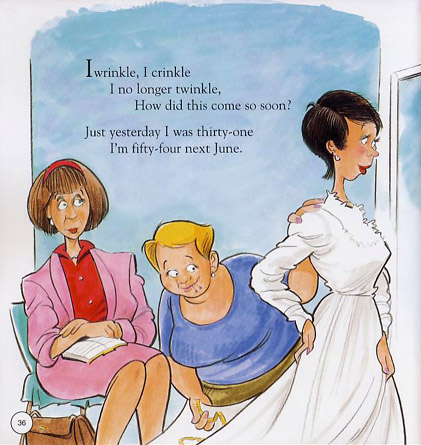
Fifty-four. I wish!
This journal entry is a continuation of the last two: why
osteoarthritis probably makes it imperative for me to give up what's
hurting my knees -- ultra running and walking -- and move on to the
Next Third (hopefully 40%) of my life without it. I'll write
mostly about my revised fitness training here and talk more
about the psychological impact in the next entry. I'll also
write soon about some of the physical challenges Jim is facing
this fall that have impacted his running and other activities.
I HAVE PLENTY OF COMPANY
Arthritis affects about 70 million Americans, according to the
Arthritis Foundation.
That's a huge number, nearly 23% of our 308 million population!
When I was diagnosed with osteoarthritis I learned that there
are about 100 different kinds of arthritis.
Osteoarthritis, caused primarily by aging
and overuse of the joints, is the most common form of the
disease with estimates of up to 27,000 sufferers. Jim's
probably got it, too, although he hasn't had an official
diagnosis yet from a rheumatologist. With thousands of Baby Boomers easing
into their 60s now, that numbers is bound to increase.
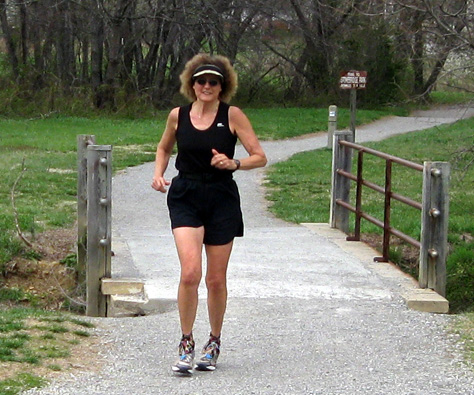
Me on my 60th birthday; with a gait like that, it's no wonder my
knees are worn out!
Women are affected more by osteoarthritis than men and require
more total knee and hip replacements than men. The angles of
their hips and the increased motion in their joints make women
more susceptible to this type of joint deterioration.
Besides my female Q-angle, I can add genetics (family history of
osteoarthritis) and thirty years of long distance running/walking/pounding
to reasons why I have had joint deterioration the past 12+ years;
I started noticing it at age 48 when the joints in the
fingers in my dominant hand started swelling. I didn't become aware
of any knee problems until my mid-50s.
Running long distances has been fantastic for many of my body systems (brain,
heart, lungs, bones, etc.) but it hasn't been kind to my
susceptible knee joints.
THE BEST ARTHRITIS PAIN RELIEVER
Jim and I attended a seminar at Carilion Clinic recently that
was presented by one of the Roanoke Orthopaedics doctors. He
talked about various treatments for osteoarthritis, including
the importance of exercise and maintaining a healthy weight.
We felt out of place in a room with so many overweight, older
folks (we're not old!!) who could barely hobble around,
but the information was helpful in a scary kind of way and we
came out feeling better about our own current states of health.
One
of the brochures attendees received from the Arthritis Foundation has a
great message:
What to Take for Arthritis Pain?
Physical Activity: The Arthritis Pain Reliever.
Not drugs, but physical activity. Imagine that!! It drives
us crazy that so many people just want to take pills to solve
their problems and don't want to exert themselves. (Yes, I
realize in some cases that drugs are the only solution.
I'm not talking about those people, just the lazy ones.)
During the lecture I hand-wrote "endorphins!" below the
message on the cover of the pamphlet. You can see it below:
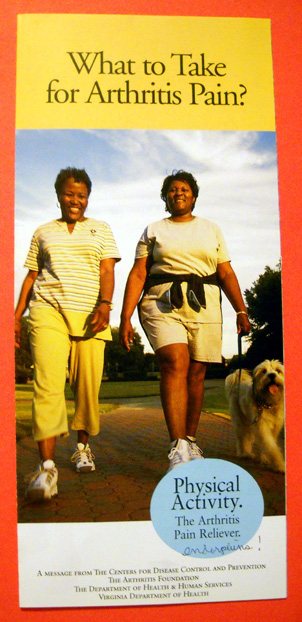
I've always joked that natural endorphins are my drug of choice. I'm as
addicted to the mellow relief they give me while I'm running or
walking long distances as I am to the sensual delights of being
outdoors in beautiful places.
It's always taken more than 30 minutes for me to reach that pleasant
physical state, however.
This booklet obviously isn't written for ultra endurance
athletes: it recommends "gradually working your way up to
30 minutes a day, three or more times a week." That sounds
laughable, even pathetic, to someone who has been 'way beyond
that for most of her life. It won't be funny any more, however,
if I get to the point that it's a struggle for me to do even
that little amount of aerobic exercise.
Perspectives sure change depending on your own circumstances!
HOW MUCH IS ENOUGH? HOW MUCH IS TOO MUCH?
The Arthritis Foundation does encourage more sedentary folks suffering
from arthritis pain to lose excess weight and practice regular moderate exercise
-- and
that's a great message. The pamphlet emphasizes that physical
activities like walking, swimming, and cycling help people feel
less pain, move more easily, do more activities, feel more
energetic and positive, and keep their muscles, bones, joints,
and heart more healthy.
Since the Foundation encourages low-impact activities,
there is no mention of running or fast walking, let alone
running or walking for hours at a time. Bummer! Same message I got loud
and clear from my knee doc.
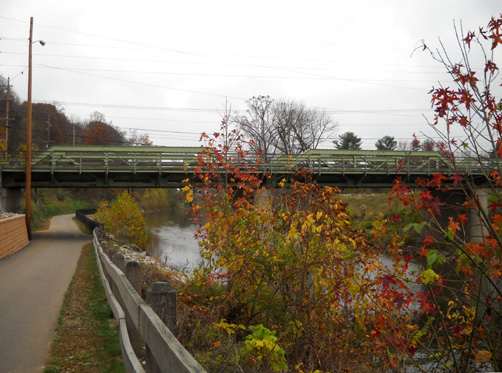
Recent views along the Roanoke River Greenway
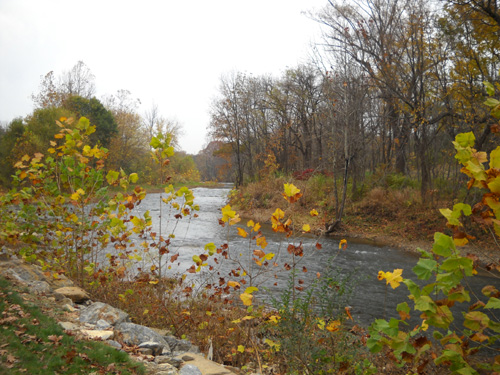
The lecturing orthopedist then focused on knee and hip
replacement surgery. Although we know several folks who've had
total knee or hip replacements over the last decade the details
in this seminar about surgery, recovery, and what you can expect
to do afterwards were still an eye-opener for us.
I like to be optimistic about still being able to do some
running after I get my knees (eventually) replaced. But even if
I'm able to retain a high level of fitness until I go into
surgery, being fit doesn't guarantee I'll be able to run with
metal and plastic knees.
This orthopedic surgeon and others I have talked with in the
last five years all say that current versions of total knee
replacements cannot withstand the impact of running for very
long, even on softer surfaces. This is what the American Academy
of Orthopaedic surgeons
website says about expected
activities after surgery:
More than 90% of individuals who undergo
total knee replacement experience a dramatic reduction of knee
pain and a significant improvement in the ability to perform
common activities of daily living. But total knee replacement will
not make you a super-athlete or allow you to do more than you
could before you developed arthritis.
Following surgery, you will be advised to
avoid some types of activity, including jogging and high-impact
sports, for the rest of your life.
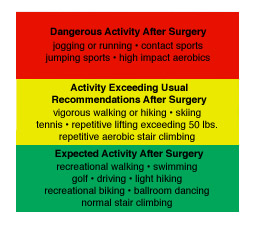
With normal use and activity, every knee
replacement develops some wear in its plastic cushion. Excessive
activity or weight may accelerate this normal wear and cause the
knee replacement to loosen and become painful. With appropriate
activity modification, knee replacements can last for many years.
|
The orthopedist conducting this seminar said that current knee
replacements last for ten years for 98% of the people who do
only low-impact activities after surgery. Eighty-five percent can
expect them to last for twenty years.
That was actually good
news to me -- I thought ten years was the max, and with
the goal of living to 100, I wasn't real keen on the idea of
getting three or four knee replacements ON EACH KNEE!! The
lecturing orthopedist said that most surgeons won't do
replacements more than twice per knee because the surgery is so
hard on the heart. I'd guess that's pretty dependent on a
person's health and fitness.
I asked the orthopedist at the seminar about getting both knees
done at once, as some people do -- fearing they'll never
get the second one done because the first surgery/recovery was
so intense. Apparently none of the surgeons in this area will do
both knees at once because of the extra stress on the
cardiovascular system; they may do the knees two weeks
apart, but even that makes PT more difficult and prolongs
recovery.
Although I've heard anecdotal evidence of runners continuing to
run long distances after getting knee or hip replacements, I
don't plan to even try unless the devices have significantly
improved when I need them. The runners I've personally
known who have had total knee or hip replacements have not
been able to run comfortably afterwards even though they had
been very fit individuals prior to surgery and really wanted to
continue to run.
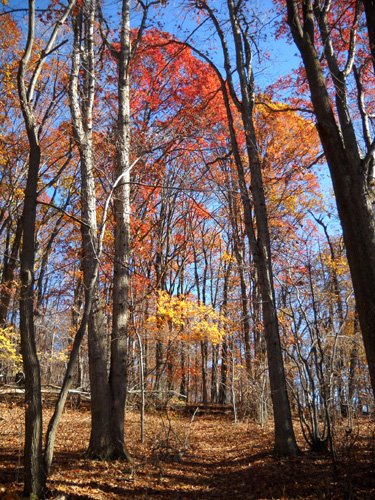
I can still hike up the trail to Stewart's
Knob along the
Blue Ridge Parkway; coming down is
harder!
The biggest take-away for me at this seminar? I want to delay
surgery as long as I possibly can!!
If that means being a good girl and eliminating most or all running NOW from my
repertoire of Favorite Things to Do, I'll stop even though it's not easy
to give up or severely limit the activity that has been my major passion for the last thirty years.
SO MAYBE I SHOULD CYCLE MORE??
Yeah, there's a good alternative for me!!
After my serious bike crash in
August, that's kind of a
standing joke now with our family and friends. At least I lived to joke about it.
Cycling is supposed to be a great non-impact aerobic sport. I've
ridden bikes since I was a little kid but it's never been my
primary sport. There are just too many mechanical hassles with
cycling -- and I'm a lousy mechanic. It's a lot easier to put on a pair of running shoes and
hit the trail. And cycling just doesn't get my heart rate up
like running or vigorous walking.
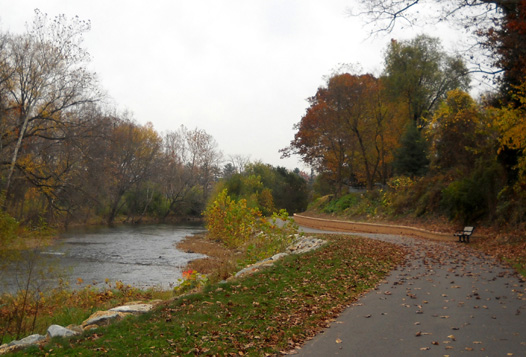
Mid-November along the Roanoke River Greenway
I've been doing cross-training as an adjunct to my running for
the last thirty years -- weight work, yoga, walking,
hiking, road and mountain biking, pool running, occasional
swimming, snowshoeing, and cross-country skiing
-- but none of those activities "do" for me what running
"does" for me mentally and physically. They just aren't as
pleasurable because they don't produce the same level of
feel-good endorphins. Some are more complicated and some don't
get me outdoors..
Maybe I've just haven't done them for long enough stretches at a
time or learned how to
do them properly because I wasn't sufficiently motivated to do
so. It's clear that I have to give
other aerobic activities a chance now that long distance running is pretty much out of my list of
sensible things for me to do.
It's such a drag to be sensible!
REPROGRAMMING THE SOFTWARE
When Jim and I went in for my knee consultation in late September
with Brent Johnson, the orthopedist I talked about in the
last
entry, we revisited his recommendations for acceptable physical
activities for someone whose knees are shot.
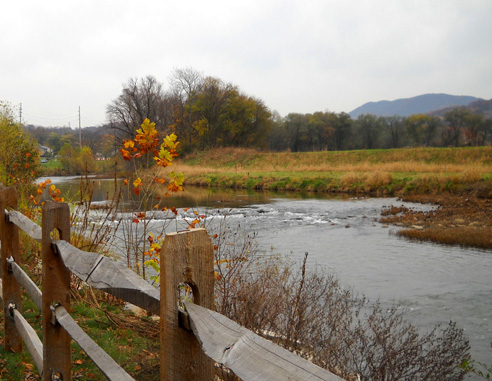
Roanoke River Greenway on a recent gray day
As both an athlete himself and a sports
medicine specialist, Dr. Johnson knows how difficult it is for athletes,
especially distance runners, to modify or give up their passion.
He laces (pun intended) practical advice with humor and analogies so his
messages get across to patients. We clearly
understood his comparison of the brain to computer software that
has to be reprogrammed when new physical problems, like my worn-out
knees, throw a monkey wrench into our lifestyles.
The message I got is that
I have to update my mental software to a newer version! As
hard-headed as I can be, however, maybe it's the hardware
that needs updating . . .
WHAT DOESN'T KILL US MAKES US STRONGER?
Dr. Johnson can base some of his advice to patients like me on personal
experience. He has one knee that is bone-on-bone and has had
to modify his own physical activities.
As soon as he mentioned
doing more cycling to take the impact off my knees, I rolled my
eyes and related
the sorry tale of my bike crash in August -- and the irony of
nearly killing myself on a simple little bike ride, an activity
that seemed so much less risky than many of my mountain
running (mis)adventures over the years..
He could definitely relate. He wryly commented that every time
he thinks about increasing his bike training he hears
about or sees yet another cyclist in his practice who has had a bad crash
. . . and he
doesn't go out to ride!
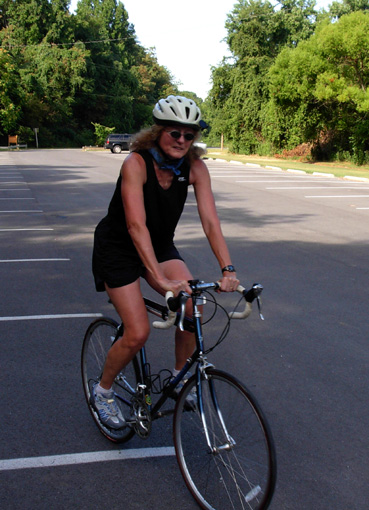
It's low impact -- until you wreck!!
He and several of our other Roanoke doctors told us the story
of a well-publicized "worst-case scenario" that we missed
while we were gone over the summer. One of the local
orthopedists went out for a ride on his bike after doing some
repair work on it at home. Apparently he didn't reattach
the back brake properly. While zooming down his steep driveway
to the street, he applied the brakes and only the front ones
worked. He somersaulted over the handle bars, landed hard --
and is now paralyzed.
He's alive, but life as he knew it is over.
That's just one example -- of too many -- of a
ride gone really, really bad. We have friends who've barely
survived nasty bike wrecks, too, and it has changed their lives
both physically and psychologically. One of our Montana friends,
Rex, has called himself "Wrecks" ever since a car ran him down
during a popular relay race near Billings several years ago. At least he was able
to retain his sense of humor despite all the surgery required to
piece his 60-year+ body back together.
RISKY BUSINESS
I have to admit that I'm more
nervous about riding either one of our bikes since my crash. The
older I get, the less risk I am willing to take with my life. No
longer do I feel as invincible as I did even five or ten years
ago. The more hairy adventures I live through, the more I realize
how short life is.
You'd think that would perhaps give me the
courage to take on more risk, but it's had the opposite affect
on me.
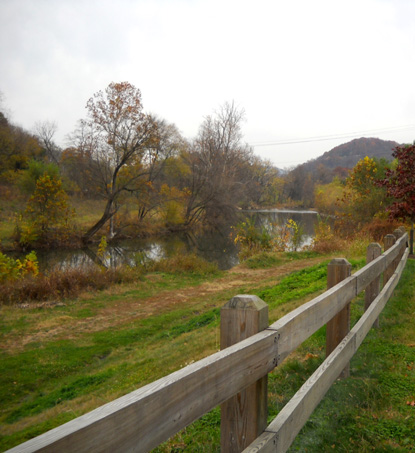
Roanoke River Greenway
Riding a bike, especially on a road with traffic, is fraught
with danger. I'd love to cycle on the nearby Blue Ridge Parkway
but Jim nearly has a stroke every time I mention it. The
segments near Roanoke are used by locals for commuter traffic.
Nearly everyone speeds to work, school, shopping. Even the
tourists don't go the legal 45 MPH speed limit on the parkway.
I really like my Terry road bike but I have very limited options around
Roanoke for riding it safely. The country roads where we live
are too narrow, hilly, dangerous (even in a truck!) to even
consider. So are any of the residential streets in town.
The only place I've found that is both paved and safe is a
5-mile section of greenway in town along the Roanoke River.
Unfortunately, two parts of it have been under
construction since we've been
here this fall and only three contiguous miles are practical to
ride. The scenery is nice but it gets really boring going back
and forth repeatedly on that little section!
Add in clueless pedestrians, little kids, and dogs at the end of
6-foot
leashes and you can imagine how frustrating a bike ride can be
to someone who's trying to get in an aerobic workout.
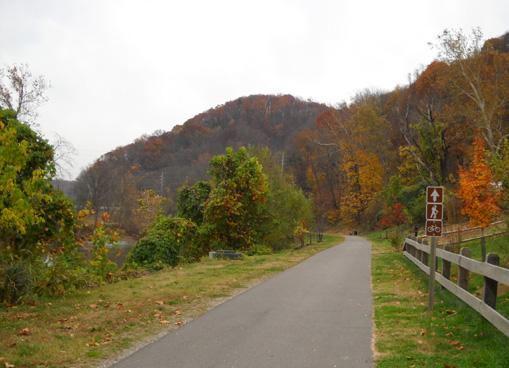
Roanoke River Greenway -- for just a moment
I can ride fast when no one's around.
Neither of us has ridden Jim's mountain bike since I crashed it.
I'm understandably a little skittish since I don't know if a
mechanical problem caused my crash (I still have no memory of
what happened). Jim has ridden it a little and doesn't think
there's anything wrong with it but we really need to take it to
a bike shop to be examined professionally so we both feel more
comfortable riding it.
Since I need to find one or more new sports to keep me sane, I'd like a
new trail bike that fits me as well as my road bike and is a
step up in quality from Jim's low-end bike. Maybe Santa will
bring me one! I have no
desire to ride on gnarly trails (my reflexes, balance, and skills aren't
that good) but I'd like to be able to ride fairly smooth dirt
roads and trails so I can get away from traffic. Jim can ride
his trail bike on roads with me but I can't ride my bike on
trails with him. We could have even more quality time together
if we both had trail bikes!
(There's some RV humor. Remember that eight to nine months of the year we
live together in a little camper!)
We plan to take both of our current bikes with us
on our winter trip to the Southwest. There are several good
trails and both paved and dirt roads that we know about in the areas
where we plan to camp in Texas and Arizona and it will be fun to
find new ones.
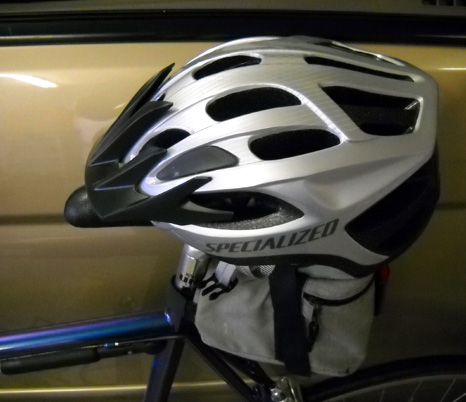
BTW, I got a sturdy new helmet (above). I'm
still curious where my old one ended up after it fell into South
Mineral Creek after the wreck and washed downstream. I like to
think it's well past
the Grand Canyon by now . . .
STAYING FIT THIS FALL
Since receiving the bad news about the condition of my knees two
months ago, I've been doing mostly walking as the primary
substitute. It's the closest I can get to running without
running and if I do it hard and long enough, it produces those
endorphins I crave -- and does good things for my cardio,
respiratory, and other systems.
Of course, Dr. Johnson even warned me about doing fast or long
distance walking. Although it has less impact than running, it's
still 2-4 times the impact of regular walking. I prefer to walk
and run on softer surfaces, so that helps lower the impact
compared to paved surfaces.
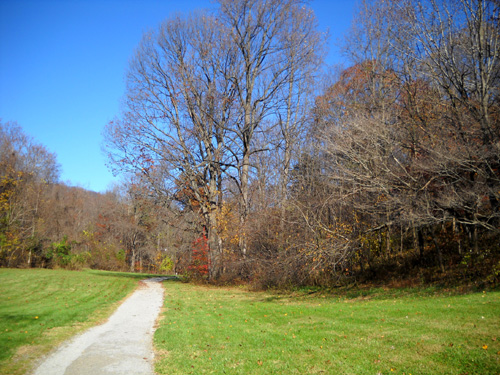
Recent view of Wolf Creek Greenway
There's another part of the greenway (above) that Jim and I often use for
running and walking. It is composed of
finely crushed rock over dirt and follows a pretty creek that Cody can
play in as he tags along with us. It's also fairly flat and farther removed
from traffic than the paved sections of the greenway downtown. It's much
easier mentally for me to do repeat out-and-backs on this
segment while walking or running than it is to do repeats when cycling on the short paved
section of the greenway system that I showed in the cloudy
photos farther up in this entry.
(If the city ever gets the entire greenway done, it will be a
great place to run, walk, and ride long distances, but so far it's just a bunch
of short, disjointed segments. Most of the delay is due to the
enormous cost of having to cross the Roanoke River several times along its length. By
the time the whole system is finished, we probably won't have a
house here any more.)
I have not completely stopped running. There are two main
reasons: I'm addicted to it (!) and I don't want to lose
all of my aerobic fitness.
I still have a resting heart rate in
the low to mid 30s. My breathing rate is very slow. My blood
pressure is low. I'm real proud of those stats and would like
to continue to amaze my medical providers for as long as
possible! If you've been an endurance athlete for very long and
you've had mishaps or surgery, you know exactly how distressed
they get in the emergency or operating room when your pulse dips
under 50 BPM -- until you remind them you're a runner.
Then they usually get it. Not always.
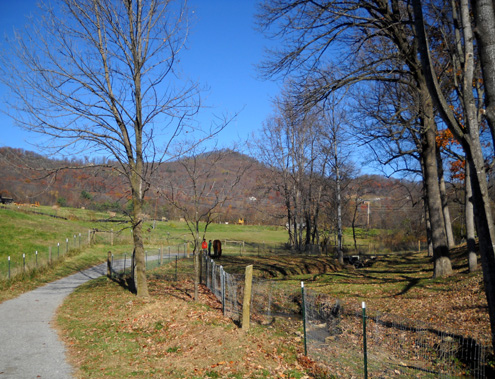
Another part of the Wolf Creek Greenway
What I've been doing in recent weeks as a compromise to both
save what precious little knee cartilage I still have left AND retain
as much of my fitness as possible is my own special version of
"hill repeats."
During each walk on the Wolf Creek Greenway or local trails, I
run up 8-10 hills for a total of one or two miles within a 4-8
mile walk.
Here's my rationale:
- So far, the bones in my knees only rub together and hurt going down,
not up.
- There is less impact running uphill than flat or downhill.
- It takes more effort to run uphill, so it's the fastest way to
increase my heart rate.
- I remember my running coach telling me 25 years ago about the
advantages of rocking my heart rate back and forth from high to low
during short repeats on the track.
- Hill work makes my legs stronger.
- Even these short (for me) bursts at higher intensity still
make me feel like a runner!
Since learning about my knee damage at the end of September, my
weekly mileage from both walking and running has ranged from
only 15 to 27 miles per week, down appreciably from earlier in
the year. The longest single run/walk has been about eight
miles. Most of it has been on flat or undulating dirt trails;
some has been hillier terrain at Explore Park, Chestnut Ridge,
Stewart's Knob, and the Appalachian Trail. We
get bored with the greenway all the time, despite nice
diversions like this:
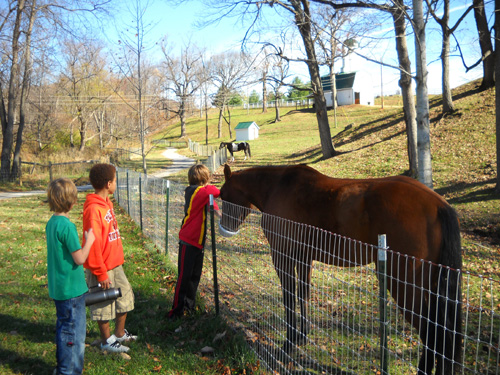
Everybody likes Cash and Presiy, two of the
horses that live next to the greenway.
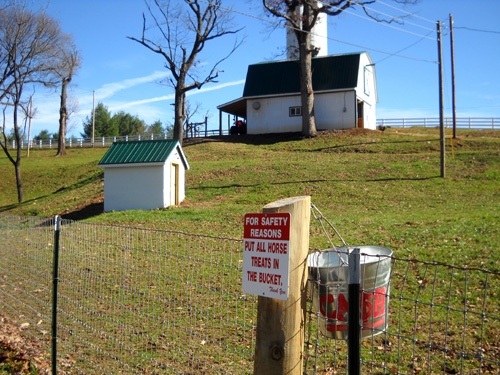
I thought they wanted CA$H until I realized
that's the name of one of the horses!
The owners want people to put the horses'
treats into the buckets. A second one says PRESIY.
Cycling has ranged from 6 to 27 miles per week, most of it on the
relatively flat, paved greenway. If I had safer opportunities
for cycling outdoors, I'd do a lot more of it.
In addition to those outside activities, I've also been going to
the YMCA every other day to use weight machines (core and
upper/lower body) for about 40 minutes
each time. On days when I don't walk or bike outside, I walk or
cycle
inside for 20-60 minutes. I do 20-30 minutes of pool running
(with no impact) once or twice a week. One of these days I'll
probably incorporate some elliptical workouts, too.
(There's only so much time in a day, even when you're retired.)
I also stretch and do yoga, abdominal crunches, and push-ups at
home every day, throughout the day. And I'm still doing
maintenance PT at home for my shoulders several times a week (I
had rotator cuff injuries last spring). All that takes from
40-60 minutes a day.
At my age, my "job" is to stay as fit and healthy as
possible for as long as possible. I learned that in the
book Younger Next Year!
Go find a copy if you haven't already read it.
"The idea is to die young as old as possible."
~ Ashley Montagu
Good plan!
In the next entry I'll talk more about how all this is affecting
my psyche.
Happy trails,
Sue
"Runtrails & Company" - Sue Norwood, Jim O'Neil,
and Cody the Ultra Lab
Previous
Next
© 2009 Sue Norwood and Jim O'Neil

















